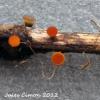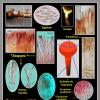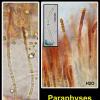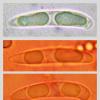
31-10-2025 09:19
 Lothar Krieglsteiner
Lothar Krieglsteiner
Can somebody provide me with a file of:Rogerson CT

09-08-2025 13:13
 Maria Plekkenpol
Maria Plekkenpol
Hello,Yesterday I found these on burnt soil. Apoth

28-10-2025 19:33
 Nicolas Suberbielle
Nicolas Suberbielle
Bonjour à tous,Je voudrais votre avis sur cette r

25-11-2016 13:54
 Stephen Martin Mifsud
Stephen Martin Mifsud
Hi, I found numerous seeds of Washingtonia robusta

28-10-2025 22:22
 Bernard Declercq
Bernard Declercq
Hello.I'm searching for the following paper:Punith

28-10-2025 15:37
Carl FarmerI'd be grateful for any suggestions for this strik

28-10-2025 11:29
 Tanja Böhning
Tanja Böhning
Hello, I found this very small (ca 0,5mm) yellow
Disco sp. - 50485
Roland Labbé,
22-12-2012 04:49
Voici un disco rouge inconnu de nous et récolté dans la région de Québec.
Et voici les données :
date de récolte : 01 / 08 / 2012
substrat : vielle tige d'herbacée
ascome jusqu'à 0,7 mm de hauteur
asques cylindriques, progressivement élargis vers l'apex, à 8 spores bisériées, sans crochet, avec appareil apical amyloïde, 75,5-97,7 x 7-10 µm
paraphyses cylindriques, avec double ramification basale et 3-5 septa, à contenu huileux d'environ 80-90%, pigmenté de jaune pâle à la base, olivâtre pâle vers la mi-hauteur et brun roux à pourpre à l'apex, 68-98,5 x 1,2-2,5 µm, dépassant les asques de 6-8 µm environ
spores cylindriques, fusoïdes à une extrémité et arrondies à l'autre, lisses, à paroi mince, non septées, à 2 grosses guttules, sans germination, 17,1-23,5 x 3,1-4,5 µm, 20,3 x 3,8 µm en
moyenne, Q moyen = 5,4
excipulum apothécial en textura porrecta, gélatinisé, formé d'hyphes parallèles ascendantes, septées, à paroi épaissie jusqu'à 1,66 µm, à segments 20,5-22,5 µm de longueur
excipulum caulinaire semblable, formé d'hyphes parallèles ascendantes
poils externes non observés
Merci de nous aider !
Amitiés, Roland
René Dougoud,
22-12-2012 09:25
Re : Disco sp. - 50485
Cher Collègue,
Les éléments de la micro me font penser à une espèce du genre Crocicreas Fr.
Amicalement
René
Les éléments de la micro me font penser à une espèce du genre Crocicreas Fr.
Amicalement
René
Roland Labbé,
22-12-2012 14:18
Re : Disco sp. - 50485
Avec le Nordic Macromycetes Vol. 1, je n'arrive à aucune possibilité dans les Crocicreas.
J'imagine qu'il doit y avoir d'autres clés pour y arriver si c'est el bon genre.
Y a-t-il quelqu'un parmi vous qui aurait la gentillesse de m'expédier une clé à jour des ces espèces ?
Merci René et à vous tous !
Roland
J'imagine qu'il doit y avoir d'autres clés pour y arriver si c'est el bon genre.
Y a-t-il quelqu'un parmi vous qui aurait la gentillesse de m'expédier une clé à jour des ces espèces ?
Merci René et à vous tous !
Roland
René Dougoud,
22-12-2012 14:50
Re : Disco sp. - 50485
Cher Roland,
Je ne dis pas que c'est un Crocicreas, mais bien que la micro, et je peux aussi ajouter, de ce que je vois, la macro, fait penser à un Crocicreas, sauf la couleur, car ne ne souviens pas qu'il y ai une espèce de cette couleur dans la monographie de Carpenter.
Je vous envoie, en privé, la clé des Crocicreas
Très Joyeux Noël et bonne année 2013
René
Je ne dis pas que c'est un Crocicreas, mais bien que la micro, et je peux aussi ajouter, de ce que je vois, la macro, fait penser à un Crocicreas, sauf la couleur, car ne ne souviens pas qu'il y ai une espèce de cette couleur dans la monographie de Carpenter.
Je vous envoie, en privé, la clé des Crocicreas
Très Joyeux Noël et bonne année 2013
René
Hans-Otto Baral,
22-12-2012 18:50

Re : Disco sp. - 50485
Alternatively it is a Hymenoscyphus.
apical ring is of that type (though that also occurs in Cyathicula), and spores look a bit scutuloid.
Zotto
apical ring is of that type (though that also occurs in Cyathicula), and spores look a bit scutuloid.
Zotto
M Jonathan,
23-12-2012 23:29
Re : Disco sp. - 50485
Could these specimen be contaminated with Viruse that then changed the color of the specimens, or from other natural cause? (weather, bruising or atypical specimens?).
On another note, I am still a novice in those species, but does it is normal for an HYmenoscyphus to have gelatinised excipulcium?
On another note, I am still a novice in those species, but does it is normal for an HYmenoscyphus to have gelatinised excipulcium?
Hans-Otto Baral,
24-12-2012 12:26

Re : Disco sp. - 50485
I must say I overlooked the striking red colour of the hymenium, I thought it is a bit photo-artificial.
On your photos of the paraphyses one can see that the pigment is inside the dead apical cells. Quite surely these contents had a pale colour in the living state and result from oxidation of refractive vacuoles. Whether these vacuoles (VBs) were hyaline or red-coloured cannot now be said, it would require living fresh apothecia. An infection I do not consider.
Zotto
On your photos of the paraphyses one can see that the pigment is inside the dead apical cells. Quite surely these contents had a pale colour in the living state and result from oxidation of refractive vacuoles. Whether these vacuoles (VBs) were hyaline or red-coloured cannot now be said, it would require living fresh apothecia. An infection I do not consider.
Zotto
Hans-Otto Baral,
24-12-2012 17:53

Re : Disco sp. - 50485
Once more: Martin has an interesting idea: your fungus could be a Dicephalospora. That genus has poalr caps at the spores, but it could be demonstrated by molecular data that Lanzia huangshanica is very closely related. These species have a dark apothecial stipe base as seems to be in your fungus, also a bright hymenial colour, yellow or red.
Zotto
Zotto
Roland Labbé,
25-12-2012 13:59
Re : Disco sp. - 50485
Lanzia huangshanica est vraiment proche.
La macro, micro et éco correspondent bien.
Toutes les dimensions aussi.
Le schéma micro y ressemble aussi beaucoup.
Se pourrait-il que ce soit un autre Lanzia ?
Roland
Meveilleuses fêtes à vous tous !
La macro, micro et éco correspondent bien.
Toutes les dimensions aussi.
Le schéma micro y ressemble aussi beaucoup.
Se pourrait-il que ce soit un autre Lanzia ?
Roland
Meveilleuses fêtes à vous tous !
Martin Bemmann,
25-12-2012 17:09

Re : Disco sp. - 50485
Hi Roland,
still there are issues with host (tree leaves for L.h. and herbacious stems in your case) and climate: Québec is maybe not comparable to southern China or Taiwan in this respect.
Could you provide closeups of the spores? You did the microscopy from dry material, right?
Best regards and joyeux Noël?!
Martin
still there are issues with host (tree leaves for L.h. and herbacious stems in your case) and climate: Québec is maybe not comparable to southern China or Taiwan in this respect.
Could you provide closeups of the spores? You did the microscopy from dry material, right?
Best regards and joyeux Noël?!
Martin
Roland Labbé,
25-12-2012 19:47
Re : Disco sp. - 50485
Yes Martin !
I will put a closeup of the spores.
The microscopy was done with dry materiel, but macro photo is on fresh specimen.
Best regards to you, merci !
Roland
I will put a closeup of the spores.
The microscopy was done with dry materiel, but macro photo is on fresh specimen.
Best regards to you, merci !
Roland
Roland Labbé,
26-12-2012 20:57
Re : Disco sp. - 50485
I have put a closup of the spores Martin !
Roland
Roland
Martin Bemmann,
26-12-2012 22:21

Re : Disco sp. - 50485
Sorry Roland,
I can't see them...
Cheers, Martin
I can't see them...
Cheers, Martin
Roland Labbé,
26-12-2012 23:02
Re : Disco sp. - 50485
They are the 4è photo !
Roland
Roland
Martin Bemmann,
27-12-2012 10:47

Re : Disco sp. - 50485
Hi Roland,
now I see...
clearly scutuloid spores as Zotto had anticipated. L. huangshanica has fusiform spores and paraphyses bent at the top which I can't recognize in your specimen either.
So it is something else, but what?
Best regards,
Martin
now I see...
clearly scutuloid spores as Zotto had anticipated. L. huangshanica has fusiform spores and paraphyses bent at the top which I can't recognize in your specimen either.
So it is something else, but what?
Best regards,
Martin
Hans-Otto Baral,
27-12-2012 10:54

Re : Disco sp. - 50485
Yes, I suppose it is a Hymenoscyphus which turned red for some reason. Perhaps H. scutula s.l. Would require vital characters to better find out. The absence of croziers would fit H. scutula, but that species has usually setulae at the spore ends.
Zotto
Zotto
Roland Labbé,
28-12-2012 02:37
Re : Disco sp. - 50485
Exactly, what mean scutuloid spores ?
Roland
Roland
Chris Yeates,
28-12-2012 02:53

Re : Disco sp. - 50485
following Bernard Declerq: "[with] the apical end rounded and more or less hooked (like in H. scutula), the basal end pointed?"
see:
http://www.ascofrance.com/forum/12546/hymenoscyphus-on-equisetum?
http://www.ascofrance.com/search_forum/19553?
Chris
see:
http://www.ascofrance.com/forum/12546/hymenoscyphus-on-equisetum?
http://www.ascofrance.com/search_forum/19553?
Chris
Hans-Otto Baral,
28-12-2012 10:10

Re : Disco sp. - 50485
Yes, exactly. In the lack of a term I named in 1985 spores that look like those of H. scutula in that way. Certainly not the best choice.... The apical hook makes the spores bilateral-symmetrical, inequilateral, often slightly curved.
Such spores are highly characteristic of many species of Hymenoscyphus, but nut not really occur in any other genus (in Calycellina sometimes they look similar).
Zotto
Such spores are highly characteristic of many species of Hymenoscyphus, but nut not really occur in any other genus (in Calycellina sometimes they look similar).
Zotto





 Spores-details-0001.jpg
Spores-details-0001.jpg